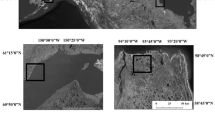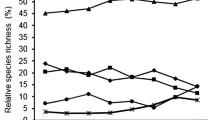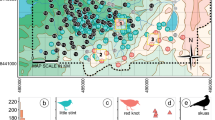Abstract
The foraging, nesting and roosting habitats of the avian fauna of a newly created Agmon wetland and surrounding cultivated peat land (5 km2) in the Hula Valley, northern Israel, were evaluated (January 1996–February 1997) to assess the value as a habitat and for wildlife tourism. We recorded 180 bird species (herons, dabbling ducks, kingfishers, waders, wagtails and raptors) in different habitats (the lake, shores, cattail and reed-bed stands, trees, temporary inundated areas). The most heavily used habitat for foraging, breeding, and roosting was a large cattail stand in the southern third of the lake. The foraging habitat and diet data of 97 avian species were determined. The most intensively used foraging habitats were cultivated fields, lake shore reed-beds, shallow canals and the cattail stand. Forty six species nested in the wetland during March-October, with 2,040 colonial and solitary nests mostly in the cattail stand, near-shore reed-beds and young trees. Roosts, also mostly in the cattail and reed-bed stands and in trees, were used by 55 species. Based on this survey of available habitats, we identified several key habitats that are either missing or require further development (e.g., temporarily inundated mud flats, reed-beds and bare islands). We also provide suggestions for improving the delicate balance between requirements of this developing wetland ecosystem and of the adjacent agricultural areas.
Similar content being viewed by others
References
Anderson, P. 1995. Ecological restoration and creation: a review. Biol. J. Linn. Soc. 56(Suppl.): 187-211.
Ashkenazi, S. and Hakham, E. 1987. Names of the vertebrates in Israel. Nature Conservation in Israel, Suppl. 1. Nature Reserves Authority, Jerusalem.
Ashkenazi, S. and Yom-Tov, Y. 1997. The breeding biology of the black-crowned night-heron (Nycticorax nycticorax) and the little egret (Egretta garzetta) at the Huleh Nature Reserve, Israel. J. Zool. Lond. 242: 623-641.
Birkhead, T.R. 1973. A winter roost of Grey Herons. British Birds 66: 147-156.
Blanco, G. 1996. Population dynamics and communal roosting of White Storks foraging at a Spanish refuse dump. Colonial Waterbirds 19: 273-276.
Britton, R.H. 1982. Managing the prey fauna. In:Scott, D.A. (ed.), Managing Wetlands and Their Birds. pp. 92-97. IWRB, Slimbridge, England.
Carothers, S.W., Johnson, R.R. and Aitchison, S.W. 1974. Population structure and social organization in southwestern riparian birds. Amer. Zool. 14: 97-107.
Cox, R.R. and Kadlec, J.A. 1995. Dynamics of potential waterfowl foods in Great Salt Lake marshes during summer. Wetlands 15: 1-8.
Degani, G., Yehuda, Y., Jackson, J., and Gophen, M. 1998. Temporal variation in fish community structure in a newly created wetland lake (Lake Agmon) in Israel. Wetlands Ecol. Managmt. 6: 151-157.
Dimentman, Ch., Bromley, H.J. and Por, F.D. 1992. Lake Hula: Reconstruction of the Fauna and Hydrobiology of a Lost Lake. The Israel Academy of Sciences and Humanities, Jerusalem.
Draulans, D. and Van Vessem, J. 1986. Communal roosting in Grey Herons (Ardea cinerea) in Belgium. Colonial Waterbirds 9: 18- 24.
Eriksson, M.O.G. 1987. Some effects of freshwater acidification on birds in Sweden. In:Diamond, A.W. and Filion, F.L. (eds.), The Value of Birds. pp. 183-190. International Council for Bird Preservation (ICBP) Tech. Pub. No. 6.
Erwin, R.M. 1989. Responses to human intruders by birds nesting in colonies: experimental results and management guidelines. Colonial Waterbirds 12: 104-108.
Erwin, R.M. 1996a. Dependence of waterbirds and shorebirds on shallow-water habitats in the mid-Atlantic coastal region: an ecological profile and management recommendations. Estuaries 19: 213-219.
Erwin, R.M. 1996b. The relevance of the Mediterranean region to colonial waterbird conservation. Colonial Waterbirds 19(Spec. Pub. 1): 1-11.
Green, A.J. 1993. The status and conservation of the Marbled Teal Marmaronetta angustirostris. International Waterfowl and Wetlands Research Bureau Spec. Publ. 23, Slimbridge.
Hafner, H. and Fasola, M. 1992. The relationship between feeding habitat and colonially nesting Ardeidae. In:Finlayson, C.M., Hollis, G.E. and Davis, T.J. (eds), Managing Mediterranean Wetlands and Their Birds. pp. 194-201. International Waterfowl and Wetlands Research Bureau Spec. Pub. 20, Slimbridge.
Hambright, K.D. and Zohary, T. 1998. Lakes Hula and Agmon: destruction and creation of wetland ecosystems in northern Israel. Wetlands Ecol. Managmt. 6: 83-89.
Hoffman, L., Hafner, H. and Salathe, T. 1996. The contribution of colonial waterbirds research to wetland conservation in the Mediterranean region. Colonial Waterbirds 19(Spec. Pub. 1): 12-30.
Kaplan, D., Oron, T. and Gutman, M. 1998. Development of macrophytic vegetation in the Agmon wetlands of Israel by spontaneous colonization and reintroduction. Wetlands Ecol.Managmt. 6: 143-150.
Kushlan, J.A. 1993. Colonial waterbirds as bioindicators of environmental change. Colonial Waterbirds 16: 223-251.
Mendelssohn, H. and Yom-Tov, Y. 1987. Appendix to volume 7: Mammals, skull and body measurements and plates. In:Alon, A. (ed.), Plants and Animals of the Land of Israel, An Illustrated Encyclopedia. pp. 111. Ministry of Defence, The Publishing House, The Society for Protection of Nature in Israel, Jerusalem.
Mitchell, J.R., Moser, M.E. and Kirkby, J.S. 1988. Declines in midwinter counts of waders roosting on the Dee Estuary. Bird Study 35: 191-198.
Poysa, H., Rask, M. and Nummi, R. 1994. Acidification and ecological interactions at higher trophic levels in small forest lakes: the perch and common goldeneye. Ann. Zool. Fenn. 31: 397-404.
Rafe, R.W., Usher, M.B. and Jefferson, R.G. 1985. Birds on reserves: the influence of area and habitat on species richness. J. Appl. Ecol. 22: 327-335.
Rehfisch, M.M. 1994. Man-made lagoons and how their attractiveness to waders might be increased by manipulating the biomass of an insect benthos. J. Appl. Ecol. 31: 383-401.
Rehfisch, M.M., Clark, N.A., Langston, R.H.W. and Greenwood, J.J.D. 1996. A guide to the provision of refuges for waders: an analysis of 30 years of ringing data from the Wash, England. J. Appl. Ecol. 33: 673-687.
Shirihai, H. 1996. The Birds of Israel. Academic Press, London.
Shmueli, M. 1996. Ecophysiology of the GreatWhite Pelican (Pelecanus onocrotalus) during migration and wintering in Israel. M.Sc. Thesis, Israel Institute of Technology, Haifa (in Hebrew, with English summary).
Shy, E., Beckerman, S., Oron, T. and Frankenberg, E. 1998. Repopulation and colonization by birds in the Agmon wetland, Israel. Wetlands Ecol. Managmt. 6: 159-167.
Tsipris, J. and Meron, M. 1998. Climatic and hydrological aspects of the Hua restoration project. Wetlands Ecol. Managmt. 6: 91- 101.
Tucker, G.M. and Heath, M.F. 1994. Birds in Europe: Their Conservation Status. Birdlife International (Birdlife Conservation Series No. 3) Cambridge, U.K.
Weller, M.W. 1990. Waterfowl management techniques for wetland enhancement, restoration and creation useful in mitigation procedures. In:Kusler, J.A. and Kentula, M.E., (eds), Wetland Creation and Restoration, the Status of the Science. pp. 517-528. Island Press, Washington DC.
Yom-Tov, Y. and Mendelssohn, H. 1988. Changes in the distribution and abundance of vertebrates in Israel during the 20th century. In:Yom-Tov, Y. and Tchernov, E. (eds), The Zoogeography of Israel. pp. 514-547. Dr. W. Junk, Dordrecht.
Zahavi, A. 1957. The breeding birds of the Huleh swamp and lake (Northern Israel). Ibis 99: 600-607.
Author information
Authors and Affiliations
Rights and permissions
About this article
Cite this article
Ashkenazi, S., Dimentman, C. Foraging, roosting, and nesting habitats of the avian fauna of the Agmon wetland, northern Israel. Wetlands Ecology and Management 6, 169–187 (1998). https://doi.org/10.1023/A:1008488607329
Issue Date:
DOI: https://doi.org/10.1023/A:1008488607329




